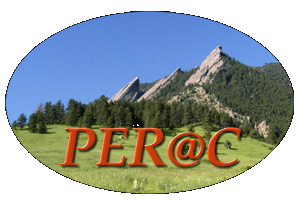
 | QMCS(Quantum Mechanics Conceptual Survey)** |
Welcome!
The QMCS (Quantum Mechanics Conceptual Survey) has been developed as part of the PhET (Physics Education Technology) Project and the PER@C (Physics Education Research Group at Colorado).
The purpose of the QMCS is to provide an accurate assessment of students' understanding of the most fundamental concepts in quantum mechanics. This kind of assessment is important for improving education in quantum mechanics and modern physics courses, both to determine what reforms are necessary and to evaluate the effectiveness of reforms. The QMCS is inspired by the many carefully researched and validated tests of conceptual understanding that have been developed in other areas of physics, such as classical mechanics1,2 and electromagnetism3,4. In keeping with the spirit of these tests, we have attempted to write the QMCS using clear, simple, everyday language that is independent of the specific notation used in any particular class, avoiding jargon to the degree possible given the nature of the subject matter.
The questions in the QMCS are based on faculty interviews, studies of textbooks and syllabi, existing conceptual tests of quantum mechanics5,6, research studies of student misconceptions7,8,9, and our own interactions with students and observations of how they think about the subject. The questions have been tested in student interviews to ensure that students interpret them in the way they were intended.
Ultimately, we would like
this test to be widely used across many different courses in modern
physics and quantum mechanics. To ensure that our results are not
distorted by students seeing the test before taking it in a classroom
setting, it is important to maintain security. The assessment is
password protected and access is restricted to authorized physics faculty and
graduate students only. If you are a physics faculty member or graduate
student, you can access the materials by going to the PhysPort site .
(The
original author of the instrument is Sam McKagan, at sam.mckagan@gmail.com, but the PhysPort site is now the recommended first place
to go to access materials and get more information. )
This project is funded by:
 The National
Science Foundation
The National
Science Foundation
**Several questions on the QMCS are adapted from references 5, 7, 9, and 10 below.
D. Hestenes, M. Wells, and G. Swackhammer, “Force Concept Inventory,” The Physics Teacher. 30, 141-151 (1992). http://modeling.asu.edu/R&E/Research.html
R. K. Thornton, and D. R. Sokoloff, “Assesing student learning of Newston's laws: The Force and Motion Conceptual Evaluation and the Evaluation of Active Learning Laboratory and Lecture Curricula,” American Journal of Physics 66, 338-352 (1998).
D. P. Maloney, T. L. O'Kuma, C. J. Hieggelke, and A. Van Heuvelen, “Surveying students' conceptual knowldge of electricity and magnetism,” American Journal of Physics 69, S12-S23 (2001).
R. Chabay and B. Sherwood, “A Brief Electromagnetism Assessment,” Unpublished.
E. Cataloglu and R. Robinett, “Testing the development of student conceptual and visualization understanding in quantum mechanics through the undergraduate career, American Journal of Physics 70, 238 (2002).
C. Singh, “Student Understanding of Quantum Mechanics, American Journal of Physics 69, 885-895 (2001).
B. Ambrose, “Investigating student understanding of the wave-like properties of light and matter, Doctoral Thesis, 1999.
D. Styer, “Common misconceptions regarding quantum mechanics, American Journal of Physics 64, 31 (1996)
P. Fletcher, “How tertiary level physics students learn and conceptualise quantum mechanics, Doctoral Thesis, 2004.
R. Eisberg and R. Resnick, “Quantum Physics of Atoms, Molecules, Solids, Nuclei, and Particles, New York: John Wiley and Sons, 1985.